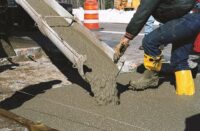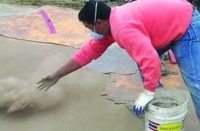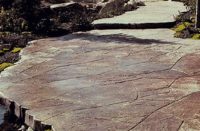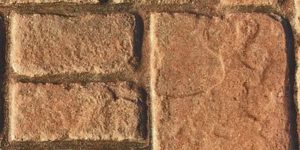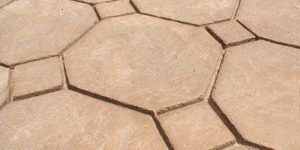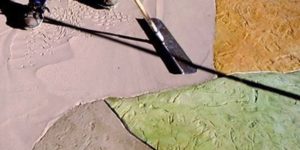
Clients like Disney are the Mount Everest of the decorative concrete industry. So the company that builds the 220-foot-tall Expedition Everest, a mountain of concrete at Walt Disney World’s Animal Kingdom, can’t climb much higher. The concrete forming and engineering company Symons can claim that peak, and several others, including features at Universal Studios and the 2008 Olympics in Beijing, China.
But while high-profile customers are important, the Symons Decorative Division gives equal attention to the distribution pipeline that leads to the everyday architect and contractor. That is this manufacturer’s route to success, says Ron Cottingham, national program manager for decorative concrete for Symons, a division of Dayton-Superior.
 Cottingham says providing information is as important as providing a product. And that information must be accessible up and down the entire sales/ distribution chain so that a contractor standing in a homeowner’s back yard can get answers on the spot. This attention to customer service is what separates Symons from its competition, Cottingham says.
Cottingham says providing information is as important as providing a product. And that information must be accessible up and down the entire sales/ distribution chain so that a contractor standing in a homeowner’s back yard can get answers on the spot. This attention to customer service is what separates Symons from its competition, Cottingham says.
Symons has been a concrete forming company based in Des Plaines, Ill., since 1901. The Symons decorative division is just one member of a large team, but it is a player with an ever-growing role as the horizons of the decorative industry expand.
The company’s history lies in industrial forms, so it was natural to branch off into decorative form liners when the field emerged. Symons claims to have the widest selection of form liners in the industry. Patterns include wood-grain, stone, brick and a wide variety of ribbed and other textures, as well as custom designs. Symons also offers the choice of four different materials to create an architectural finish:
- SPS Plastic, a polystyrene form liner for inexpensive single-use applications.
- ABS Plastic, a more durable liner, suitable for projects requiring five to 10 pours.
- Dura-Tex, a medium-range, 40-use, elastomeric material that can be stripped from complex form liner designs without damage.
- Elasto-Tex, a pure urethane form liner for projects that require 100 uses or more.
The decorative line also features the Design-Crete concrete stamping system, which produces detailed stone, brick or tile patterns with authentic-looking textures. The Design-Crete system can be applied to almost any newly placed horizontal concrete interior and exterior surface.
 Another product for new pours is the Texture-Rite system, a concrete patterning process that requires color hardener, paper stencils and sealer to create a textured surface, often on borders. Slate, tile, brick and stone are some of the more common patterns.
Another product for new pours is the Texture-Rite system, a concrete patterning process that requires color hardener, paper stencils and sealer to create a textured surface, often on borders. Slate, tile, brick and stone are some of the more common patterns.
To upgrade plain, damaged or stained concrete, Symons offers its Spray-Rite system, a polymer-modified cement system that provides a thinset surface in a variety of colors and pattern templates.
Symons also offers a Stampable Overlay System, used to improve existing surfaces. This stampable, color-infused cementitious topping, resistant to ultraviolet light and water intrusion, provides a color-stable surface that minimizes spalling and cracking.
Symons’ wide selection of products — which also includes integral colors and penetrating stains and coatings for both vertical and horizontal surfaces — requires a strong technical support team. Cottingham believes Symons’ training and technical service are the best in the business.
Marketing begins at the local level. Once each month a date is set for a regional training seminar for architects and contractors. Before anyone is invited, Symons’ team of three specifiers is deployed to gather information about t he local market: what is in style, who does the work. They study specific architects to learn their fields and specialties before ever approaching them. This targeted approach is much more effective than mass mailing or cold calling, Cottingham says. “These architects get information overload; in order to be successful you have to listen and understand their needs. They don’t want a product pitch, they want a creative problem solver.”
he local market: what is in style, who does the work. They study specific architects to learn their fields and specialties before ever approaching them. This targeted approach is much more effective than mass mailing or cold calling, Cottingham says. “These architects get information overload; in order to be successful you have to listen and understand their needs. They don’t want a product pitch, they want a creative problem solver.”
Once the Symons specifier team understands the architectural firm’s needs, the professional is invited to the four-hour training. “There we encourage a dialogue that allows the professional to pick our brains on the areas that are most important to them and their clients. Every project has a uniqueness to it, and once we understand what they are trying to achieve, we can ensure the solution meets all of their design criteria.”
As a manufacturer, Symons’ doesn’t have a lot of direct contact with contractors, but it keeps them in mind when designing products and technical service programs. “We have to stop and think about what that guy is up against every day,” Cottingham says. Those daily challenges include cash flow, time, investment in equipment and, he says, “If I have a question, where do I call?”
It’s the job of the manufacturer to make sure that the distributor and the contractor can make the product perform in the field, Cottingham says. “We are like an insurance policy. Calls come in at all hours to the 24-hour technical assistance line. When they call is when they need an answer to a unique situation. The most important thing is that we get them an answer.”
 Cottingham believes that the industry as a whole needs to do a better job at educating contractors and architects. He sees the industry headed toward more standardization and national certification programs. Decorative concrete has grown so fast, he says, that this area has not quite caught up with itself.
Cottingham believes that the industry as a whole needs to do a better job at educating contractors and architects. He sees the industry headed toward more standardization and national certification programs. Decorative concrete has grown so fast, he says, that this area has not quite caught up with itself.
Another area where the industry has not quite caught up is safety. Cottingham feels that the industry needs to move more quickly to create less volatile products. Symons continues to develop new innovative products that address the technical needs of the marketplace, such as sealers that are VOC-compliant, yet won’t cause decorative concrete to blush. “Once the technical need is met, we ensure that the whole sales team from manufacturer to contractor is properly trained,” Cottingham added. “In doing so we ensure our customer’s customer has the right system installed correctly.”
Attention to safety is one reason Symons has the Mount Everest job at Walt Disney World. The four-year project, which is the setting for a high-speed train, is carved concrete with liquid integral colors and both reactive and water-based stains, for an amusement park ride that is classified as non-hazmat, user-friendly and environmentally friendly. The complete Symons decorative system has met and surpassed strict Disney codes while extending the life expectancy of the architectural finish and maintenance schedules by more than 40 percent over previous types of architectural finishes, Cottingham says.
